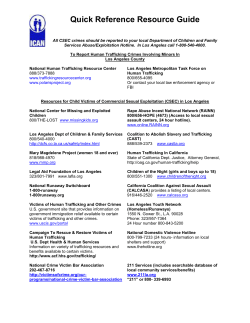
Civil Litigation on Behalf of Victims of Human Trafficking
Civil Litigation on Behalf of Victims of Human Trafficking Kathleen Kim Associate Professor Loyola Law School kathleen.kim@lls.edu Charles Song Pro Bono Manager Howrey, LLP SongC@howrey.com Dan Werner Deputy Director, IJP Southern Poverty Law Center daniel.werner@splcenter.org Civil Human Trafficking Cases: General Reflections on Litigated Cases How many cases? Where have cases been litigated? What types of industries? Who are the plaintiffs? Who are the defendants? How much $$ have clients received? The Anatomy of a Civil Trafficking Case What to consider before taking a case Your resources Client’s safety Psychological, social, economic and legal stability of client Defendant’s location and assets Impact of and on a criminal investigation/prosecution Other civil litigation pros/cons Do No Harm Excellent representation requires: Cultural competence Therapeutic lawyering Understanding and collaborating with your client, who is an equal partner in the process Your Client Wants to Move Forward Identify your allies Determine whether your client applied for and received a T or U visa Determine whether there is an ongoing criminal case and at what stage it is Basic Procedure: Parties, Timing, Venue More than one plaintiff? More than one defendant? When to file? Where to file? Basic Procedure: Impact of a Criminal Prosecution A concluded criminal case may help a civil lawsuit: Judicial/collateral estoppel Evidence Other benefits: client’s safety, restitution An ongoing criminal prosecution may complicate a civil lawsuit: The “stay” Basic Procedure: Protective Mechanisms Use pseudonyms in the complaint to protect the identity of the trafficked client. Seek a temporary restraining order and/or preliminary injunction to prevent the defendant from contacting your client. Motion for protective orders to prevent the defendant’s discovery of your client’s identification information. Basic Procedure: Final Thoughts Defense tactics Client’s credibility Aggressive discovery Settlement negotiations Calculating damages Causes of Action Trafficking Victims Protection Reauthorization Act of 2003 Racketeer Influenced and Corrupt Organizations Act Thirteenth Amendment and Involuntary Servitude Alien Tort Claims Act Title VII Sec. 1981 Sec. 1985(3) Fair Labor Standards Act Migrant and Seasonal Agricultural Worker Protection Act State torts and contract claims State labor codes and other statutes Causes of Action: TVPRA of 2003, 18 U.S.C. § 1595 Provides a private right of action for damages and attorneys’ fees for violations of: 18 U.S.C. § 1589: Forced labor obtaining labor or services by (1) threats of serious harm to, or physical restraint against victim or another person; (2) scheme, plan, etc. causing victim to believe she’d suffer serious harm or physical restraint if labor/services not performed; (3) abuse or threatened abuse of law or the legal process. Causes of Action: TVPRA of 2003, 18 U.S.C. § 1595 18 U.S.C § 1590: Trafficking with respect to servitude “Whoever knowingly recruits, harbors, transports, provides, or obtains by any means, any person for labor or services in violation of this chapter…” “…this chapter” is Chapter 77 of the U.S. criminal code, which includes all peonage, involuntary servitude, and forced labor provisions. Causes of Action TVPRA of 2003, 18 U.S.C. § 1595 18 U.S.C § 1591: Sex trafficking “whoever knowingly … recruits, entices, harbors, transports, provides, or obtains by any means a person; or benefits, financially or by receiving anything of value, from participation in a venture … knowing that force, fraud, or coercion … will be used to cause the person to engage in a commercial sex act, or that the person has not attained the age of 18 years and will be caused to engage in a commercial sex act… .” Causes of Action TVPRA of 2003, 18 U.S.C. § 1595 General trends in the utilization of the TVPRA Meaning of “serious harm” Limitations of the TVPRA Causes of Action: RICO, 18 U.S.C. §§ 1960-1968 Treble damages for damages to business or property proximately caused – or directly related to – the violation Attorneys’ fees Civil RICO claims can be brought as a Rule 23 class action Beware! Courts HATE Civil RICO and attorneys often plead it incorrectly. See, e.g., Zavala v. Wal-Mart Stores, Inc., 393 F. Supp. 2d 295 (D.N.J. 2005) (RICO claims dismissed in human trafficking case because elements missing from each underlying predicate act). Causes of Action: RICO, 18 U.S.C. §§ 1960-1968 In a nutshell, requires a defendant to participate in the affairs of an enterprise through an ongoing pattern of racketeering activity. “Association of fact” RICO enterprise most common. “Person” must be separate from “enterprise” “Enterprise” must exist separate and apart from the racketeering activities (ie. association cannot exist solely for the purpose of racketeering). If you don’t know which enterprise to plead, think about pleading several alternatively. Causes of Action: RICO, 18 U.S.C. §§ 1960-1968 “Ongoing pattern of racketeering activity” requires the racketeering predicates are related and that they amount to or pose a threat of continued criminal activity; and at least two predicate acts of racketeering committed within a tenyear period. Causes of Action: RICO, 18 U.S.C. §§ 1960-1968 Trafficking cases may involve multiple predicate acts: Trafficking in persons (new after TVPRA) Mail and/or wire fraud* Fraud in connection with ID documents* Forgery or false use of passport Fraud/misuse of visas, permits, and other documents* Peonage and slavery Activities prohibited under Mann Act Importation of an alien for immoral use Extortion * Subject to heightened pleading requirements of Rule 9. Causes of Action: RICO, 18 U.S.C. §§ 1960-1968 Also look at RICO conspiracy under § 1962(d) a RICO conspiracy defendant need not himself commit or agree to commit predicate acts all that is necessary for such a conspiracy is that the conspirators share a common purpose if some conspirators agree to a plan in which some conspirators will commit crimes and others will provide support, the supporters are as guilty as the perpetrators. Causes of Action: 13th Amendment and ATCA 13th Amendment Criminally enforced through 18 U.S.C. 1584, which prohibits involuntary servitude Some courts have recognized an implied private right of action under this statute TVPA expanded definition of involuntary servitude to include psychological coercion ATCA Grants federal jurisdiction for “any civil action by an alien for a tort only, committed in violation of the law of nations or a treaty of the United States.” Courts have recognized slavery, forced labor and human trafficking as violations of international law Causes of Action: Civil Rights Statutes Title VII Discrimination in employment due to employee’s race, color, sex, national origin, religion, or pregnancy. Applies only to employers who have 15 or more employees. Complaint filed with the EEOC within 180 to 300 days (depending on state) of the discriminatory act. 42 U.S.C. § 1981 Discrimination in contracts/contractual relationships. Must be based on race (national origin in some cases) No EEOC/exhaustion requirement; longer statute of limitations. 42 U.S.C. § 1985(3) Conspiracy to interfere with civil rights of “any person or class of persons.” Deressa v. Gobena, 2006 U.S. Dist. LEXIS 8659, * 1617 (E.D. Va. 2006) (trafficking case) Causes of Action: Employment, Torts, and Contracts Fair Labor Standards Act Migrant and Seasonal Agricultural Worker Protection Act Torts Assault/battery, false imprisonment, intentional infliction of emotional distress, misrepresentation Negligence Contracts Breach of oral/written contract Unjust enrichment Quantum meruit Final Thoughts Human trafficking is the exploitation of immigrant workers– there is no dividing line Approach these cases with a broad perspective Co-counsel with and consult the expertise of immigrant workers’ rights organizations
© Copyright 2025





















